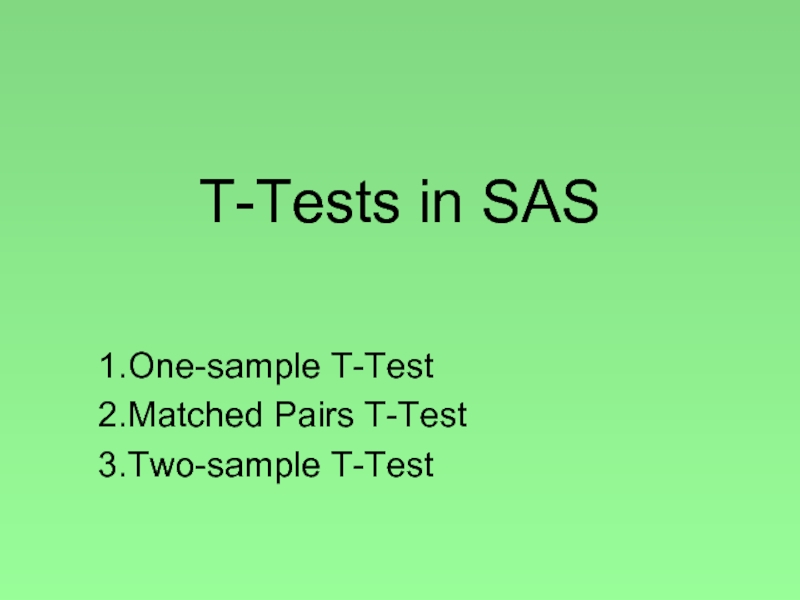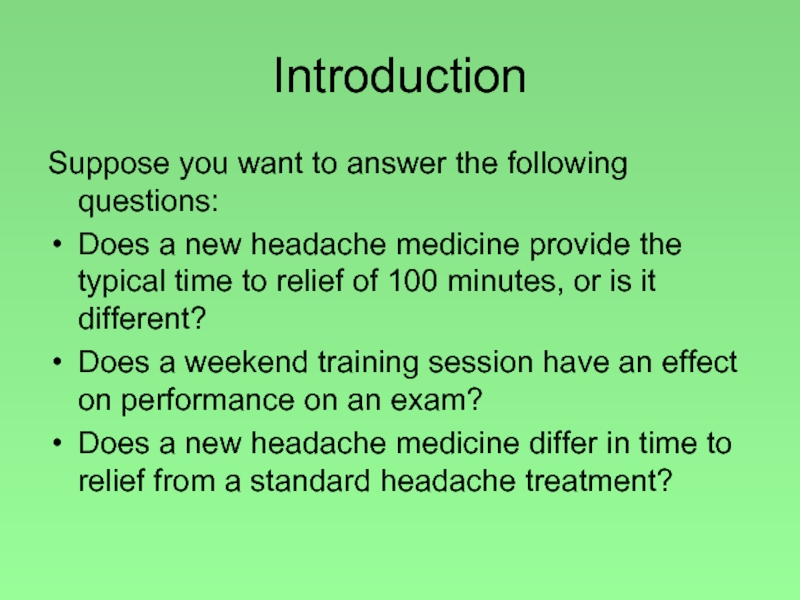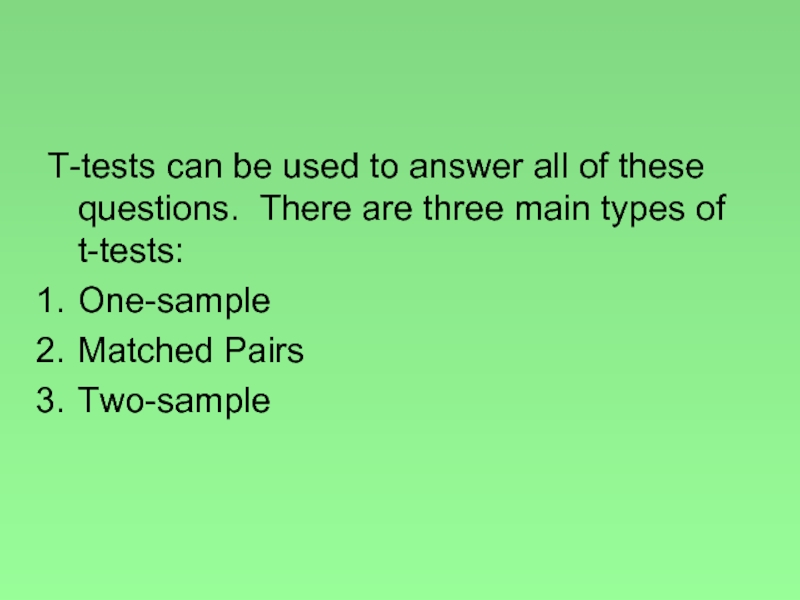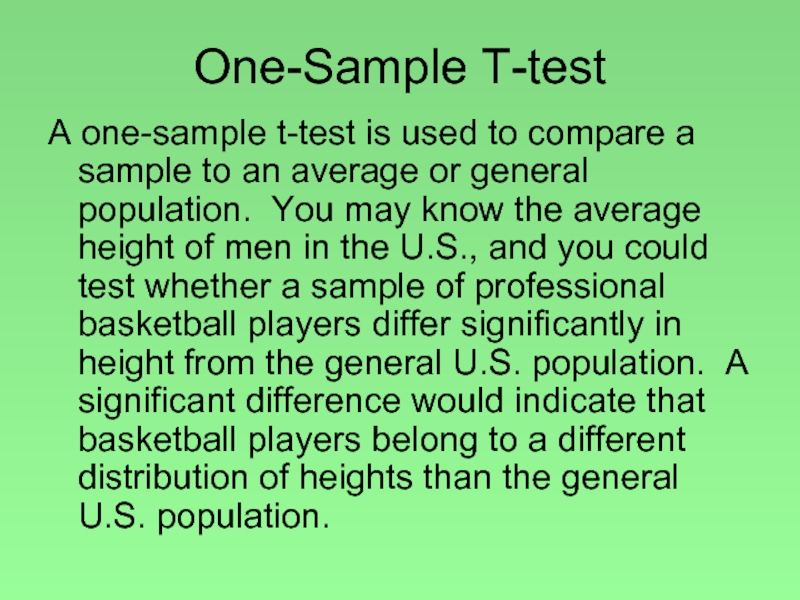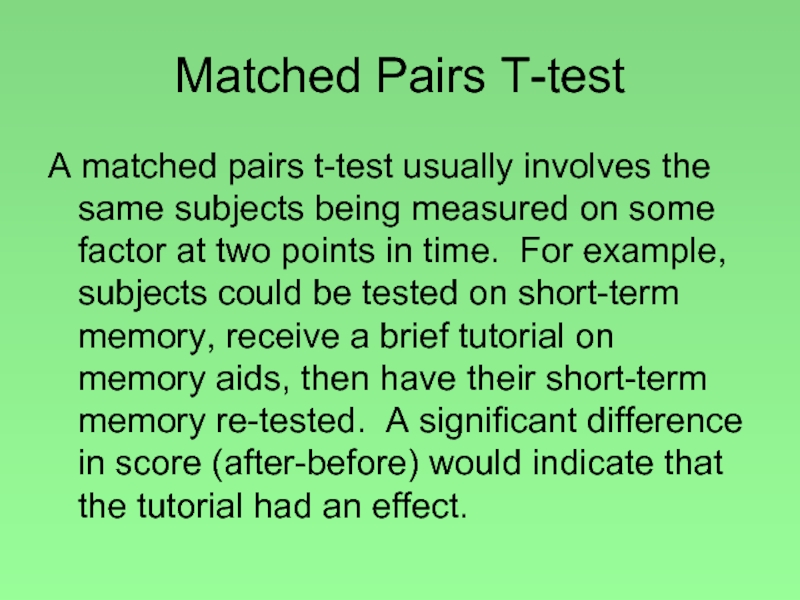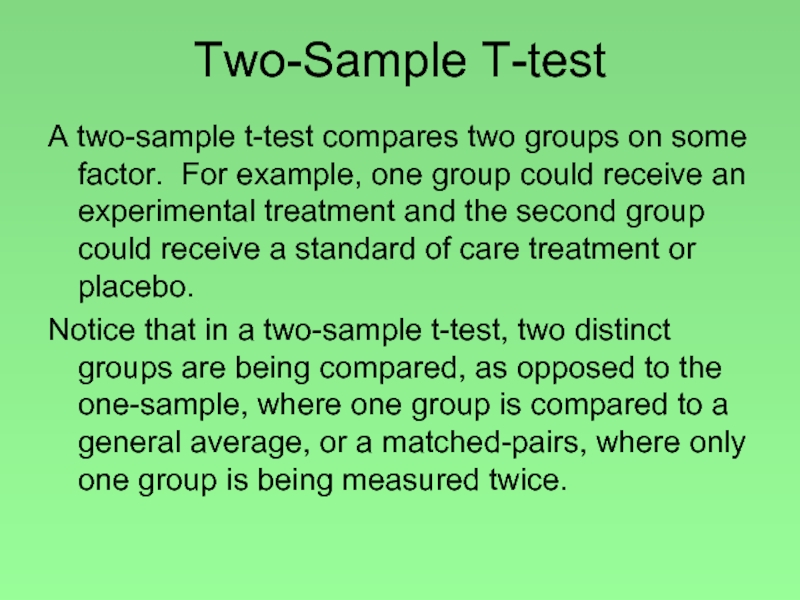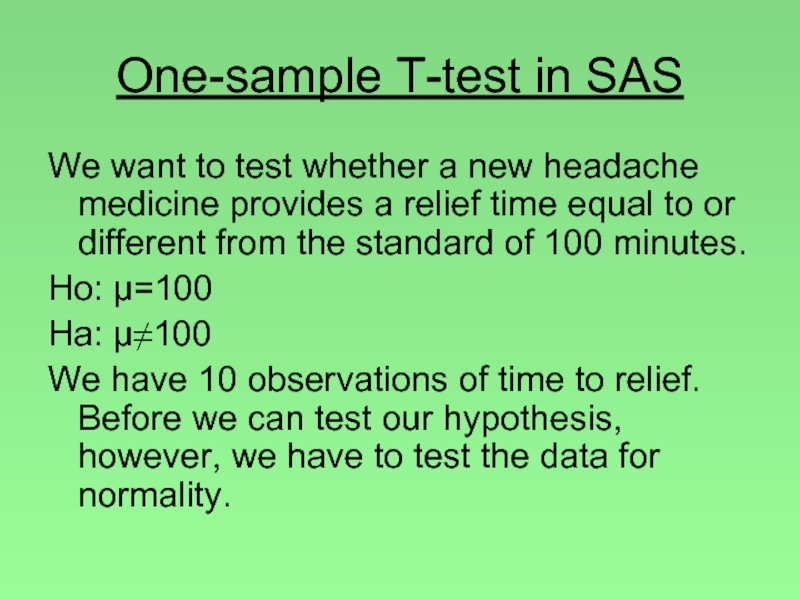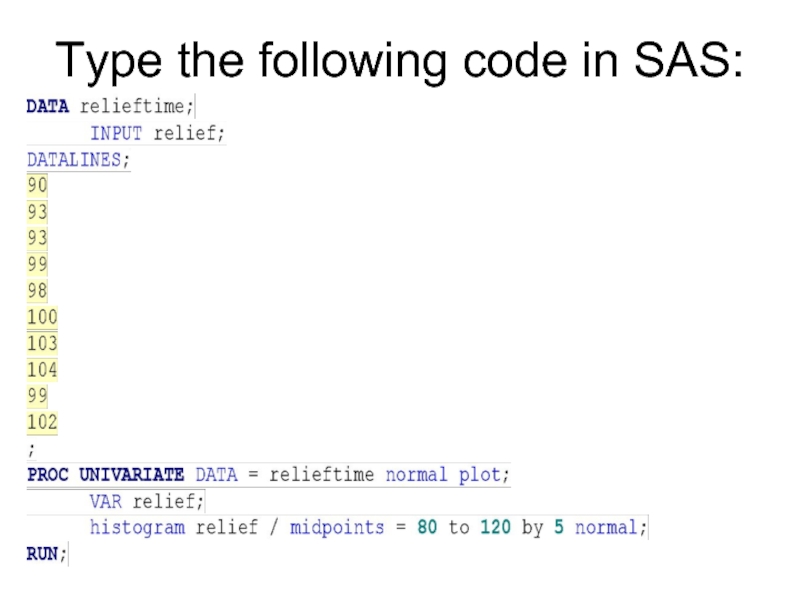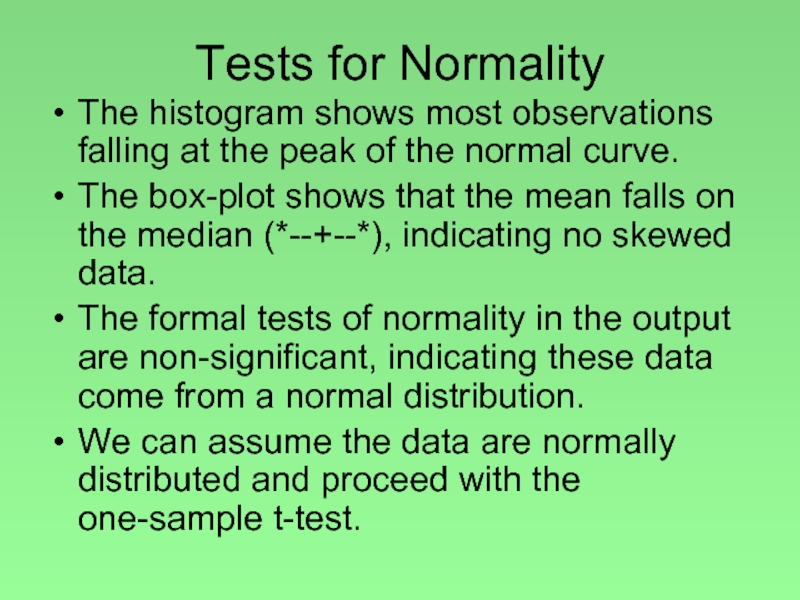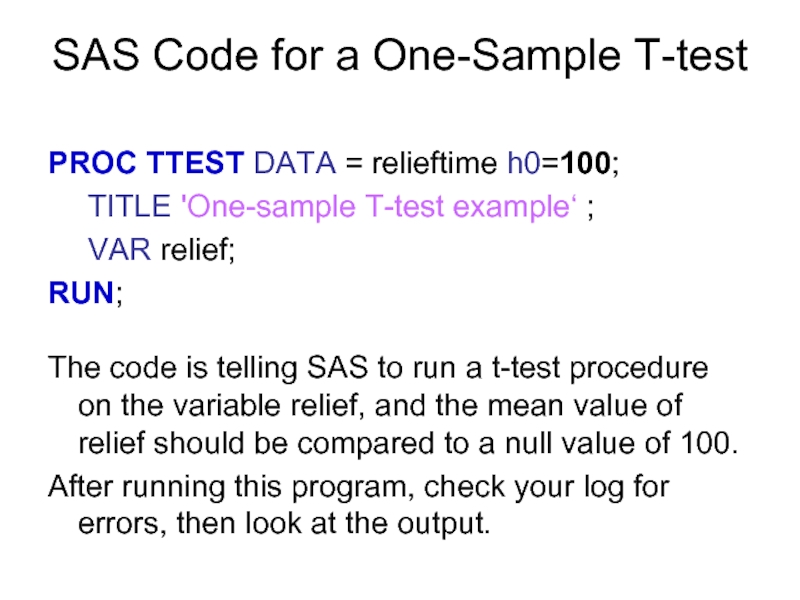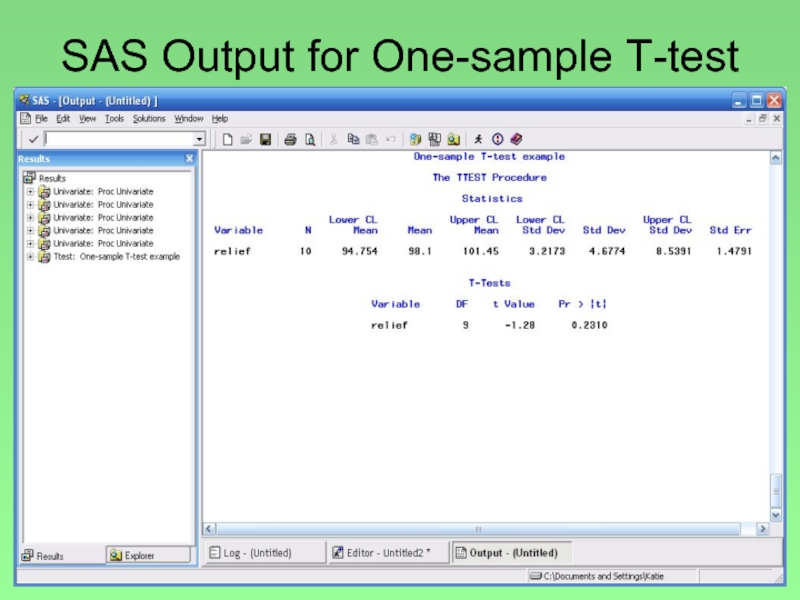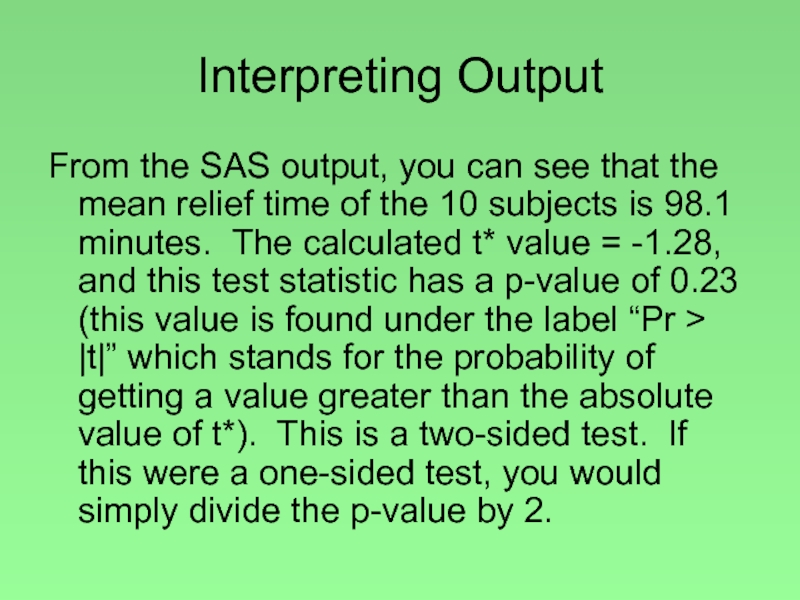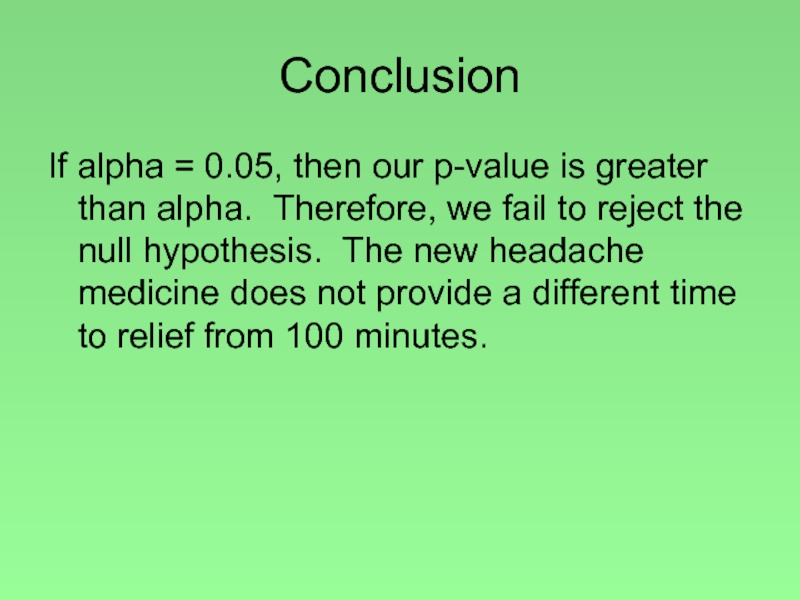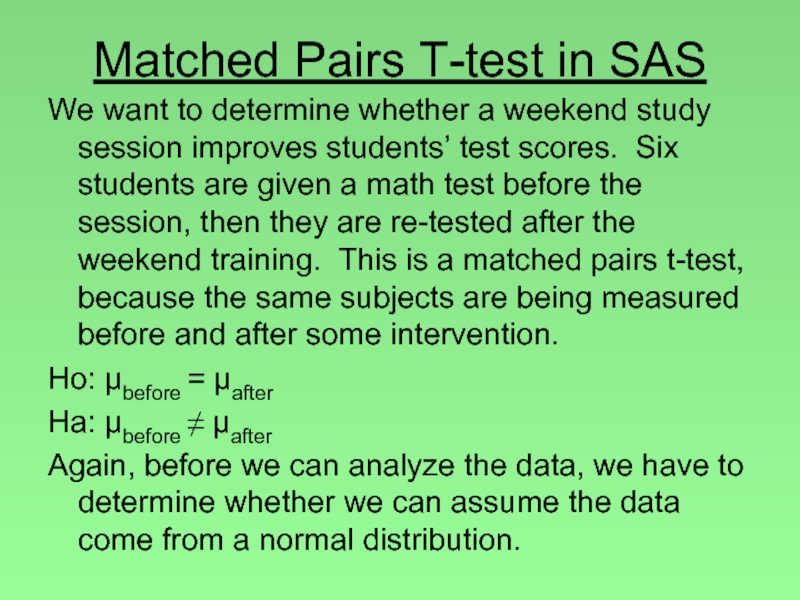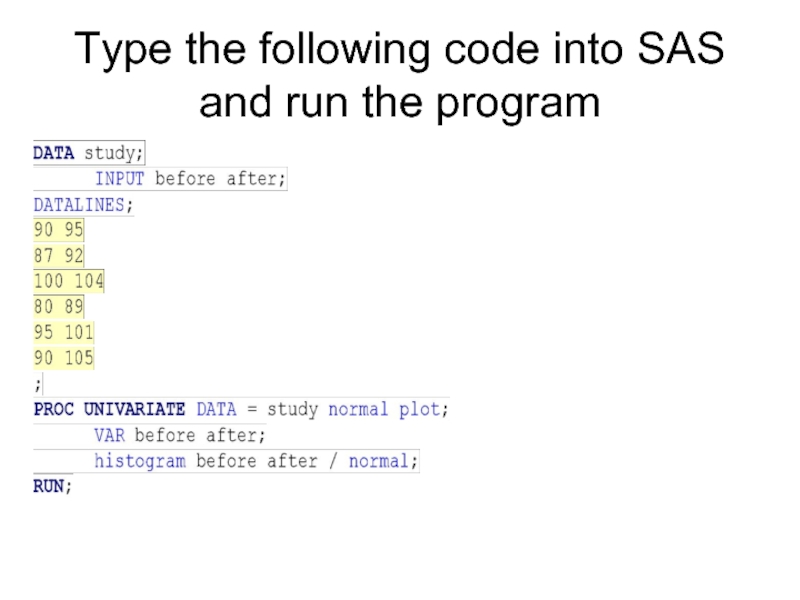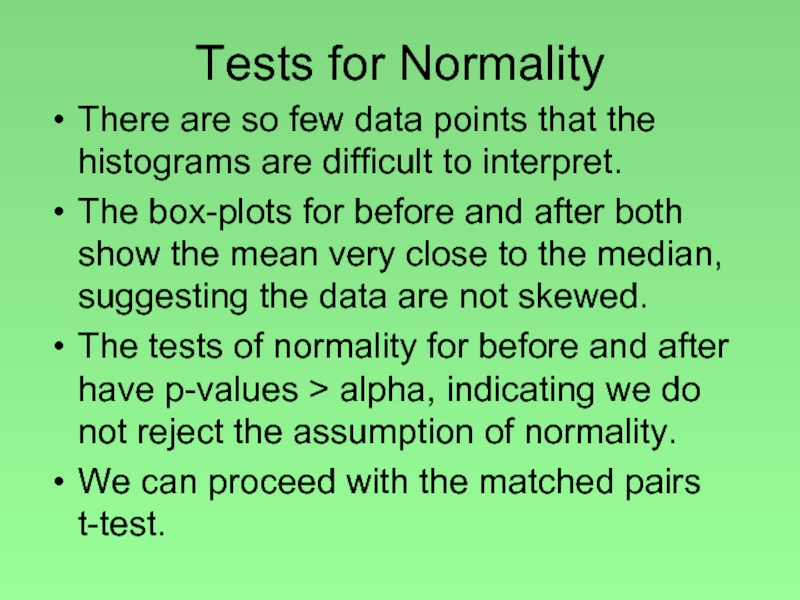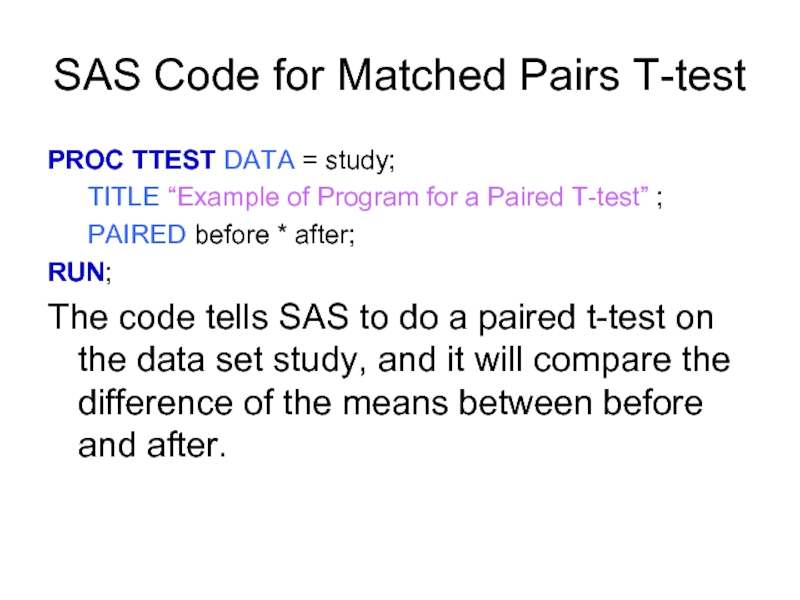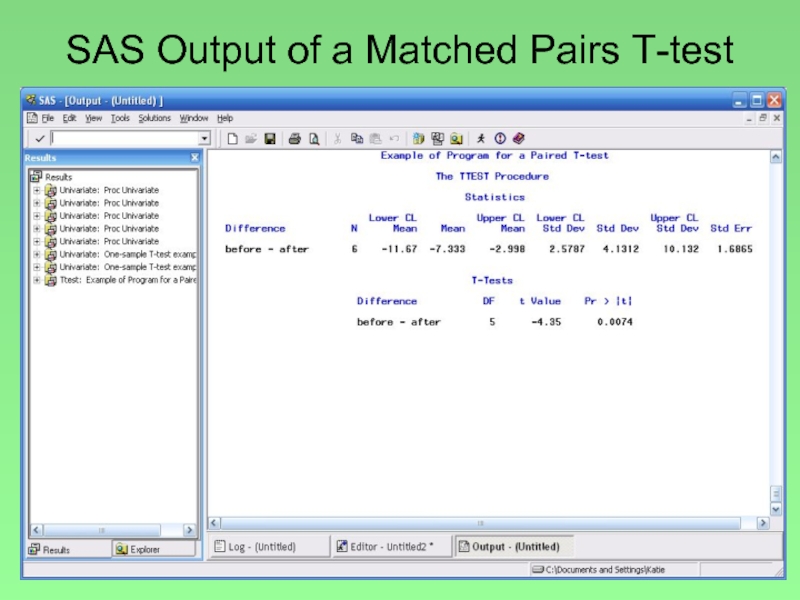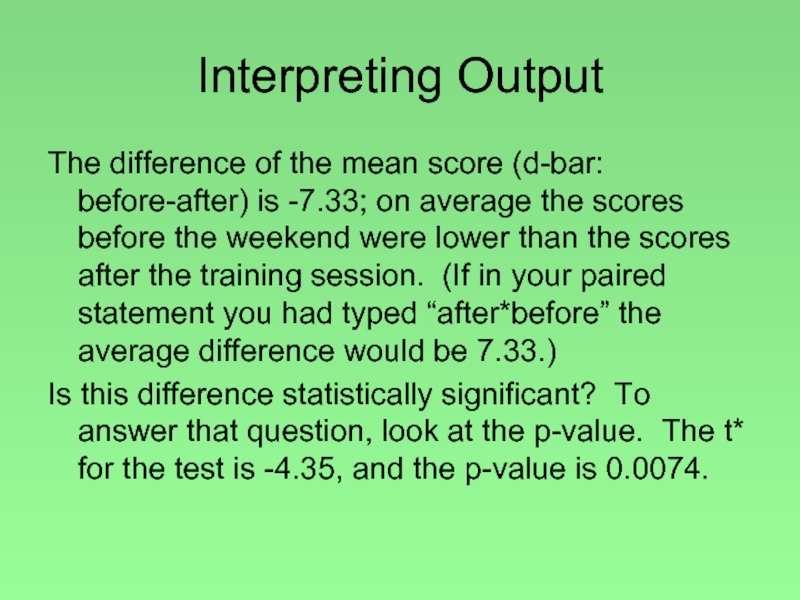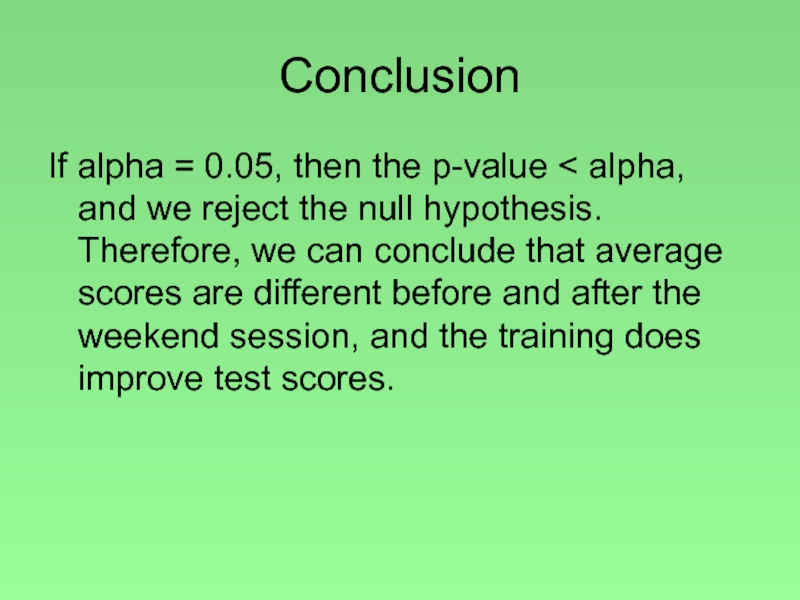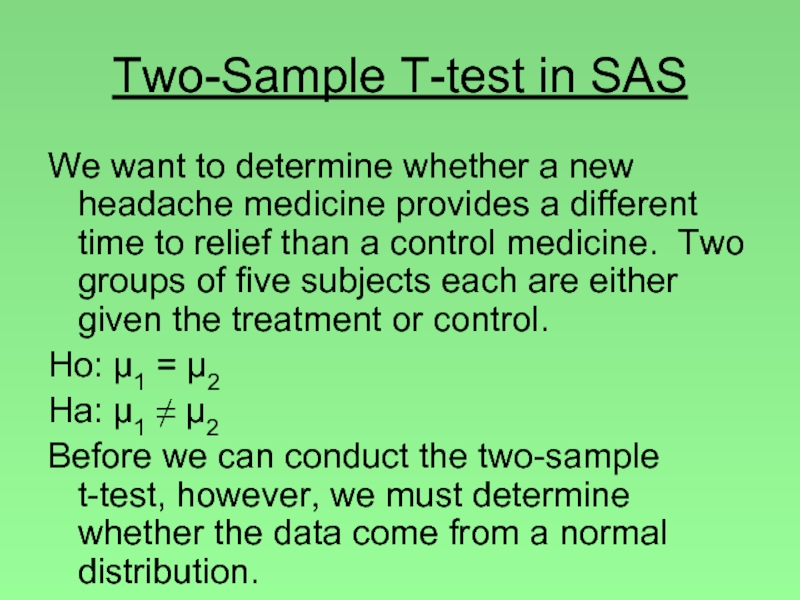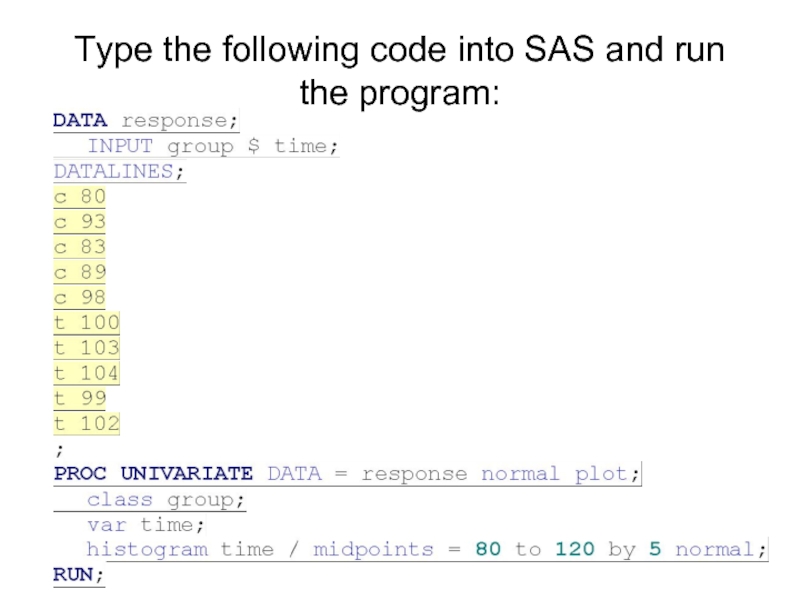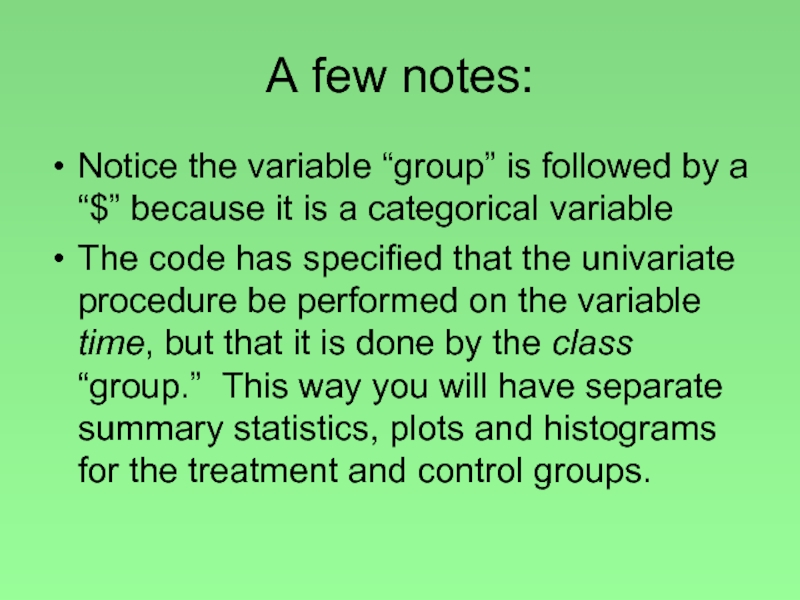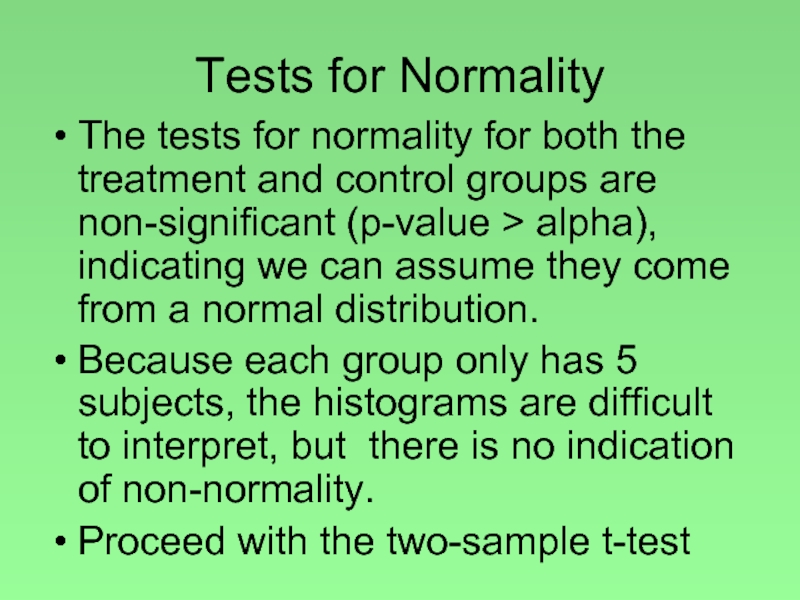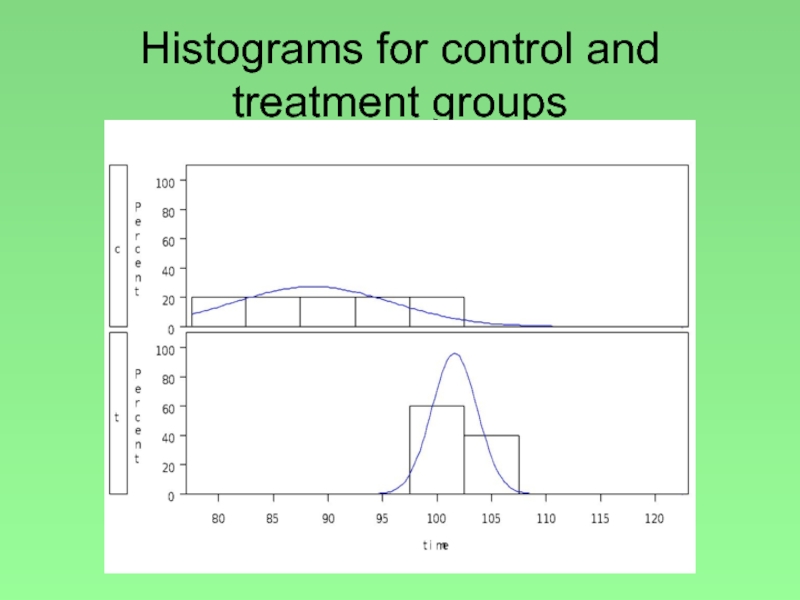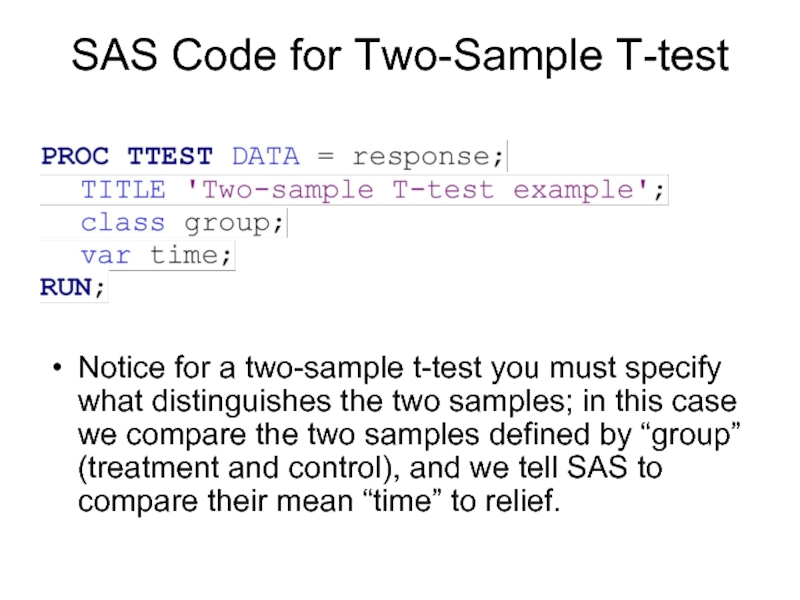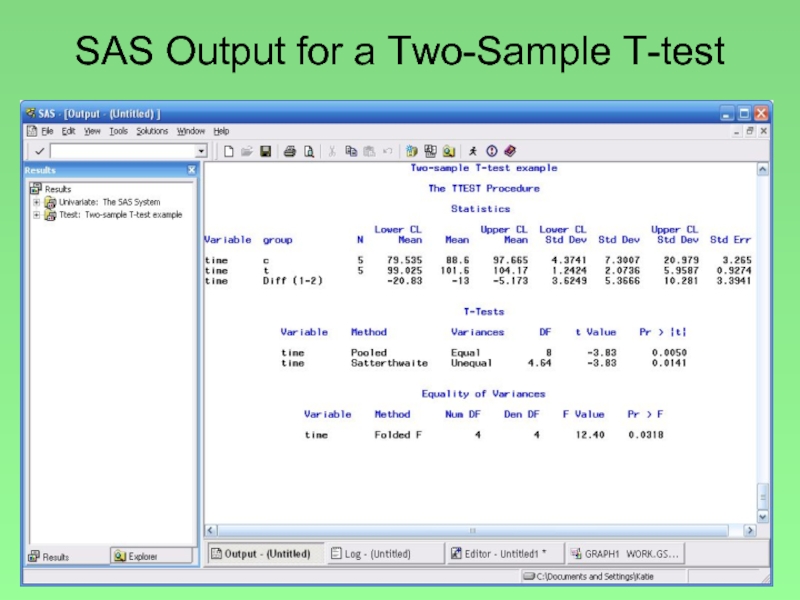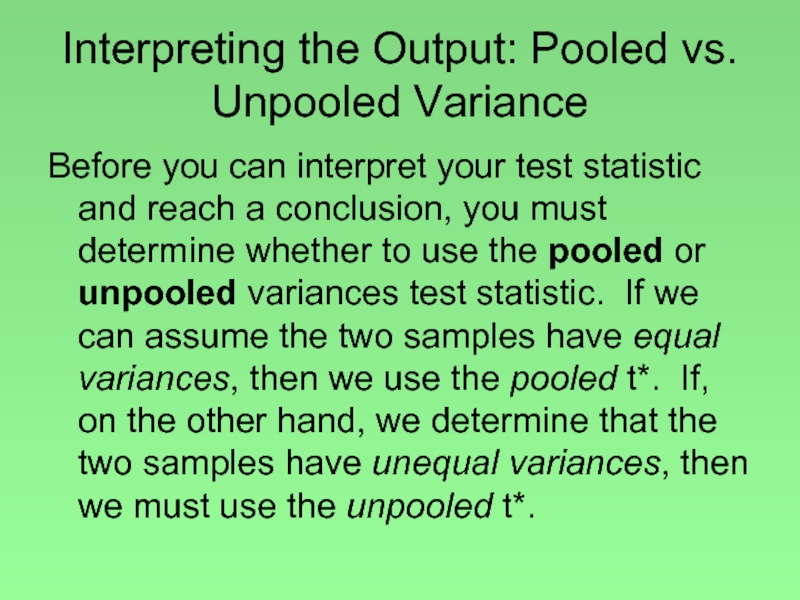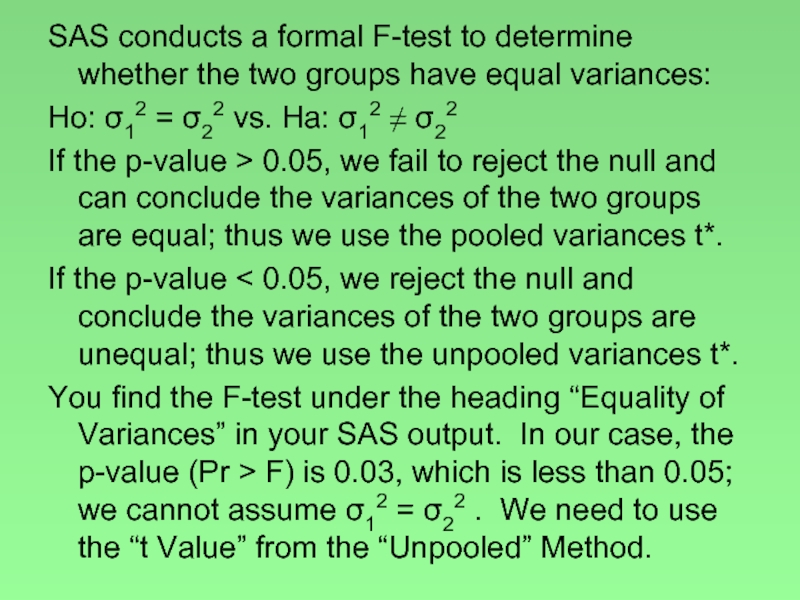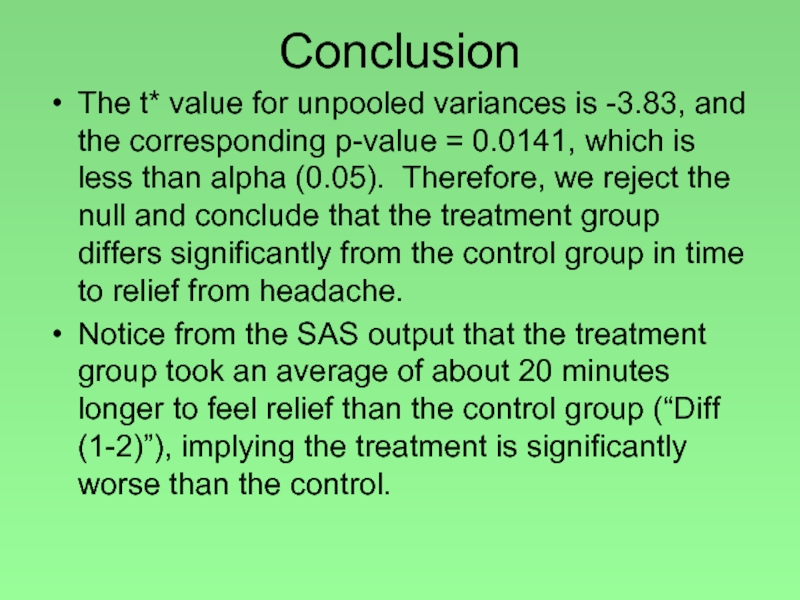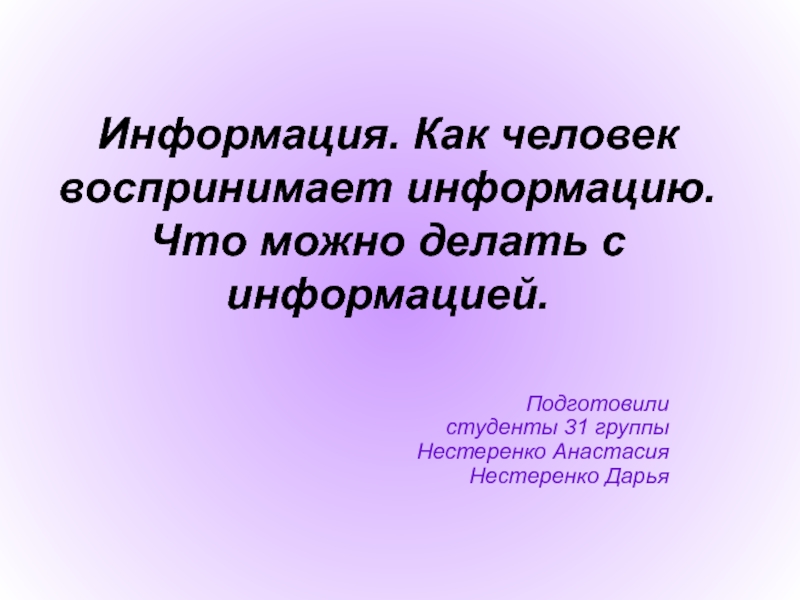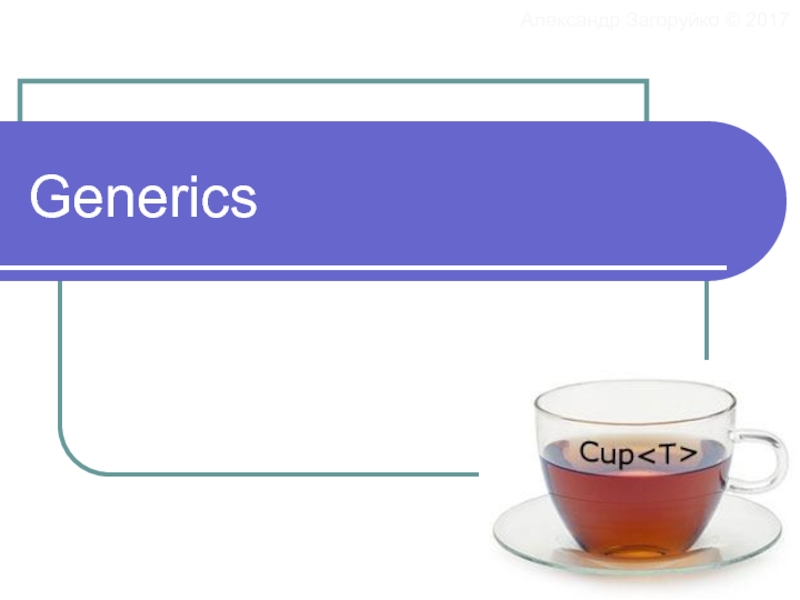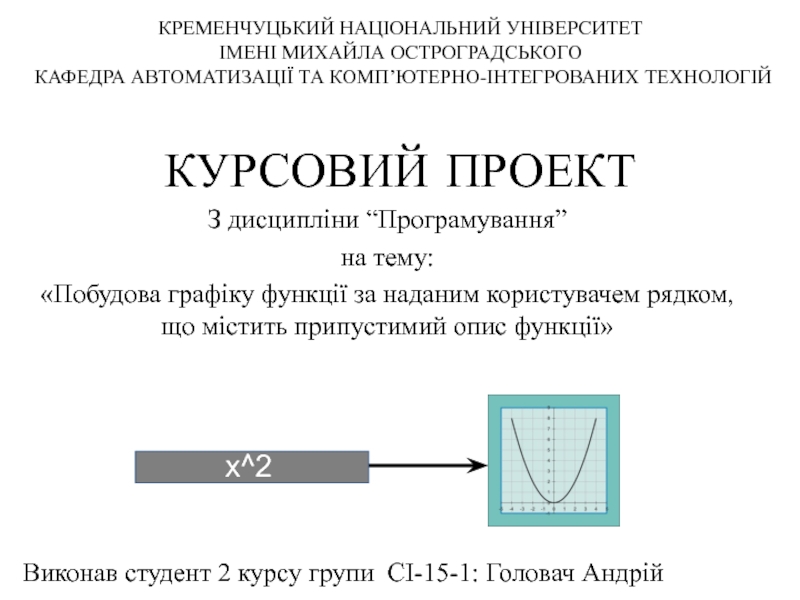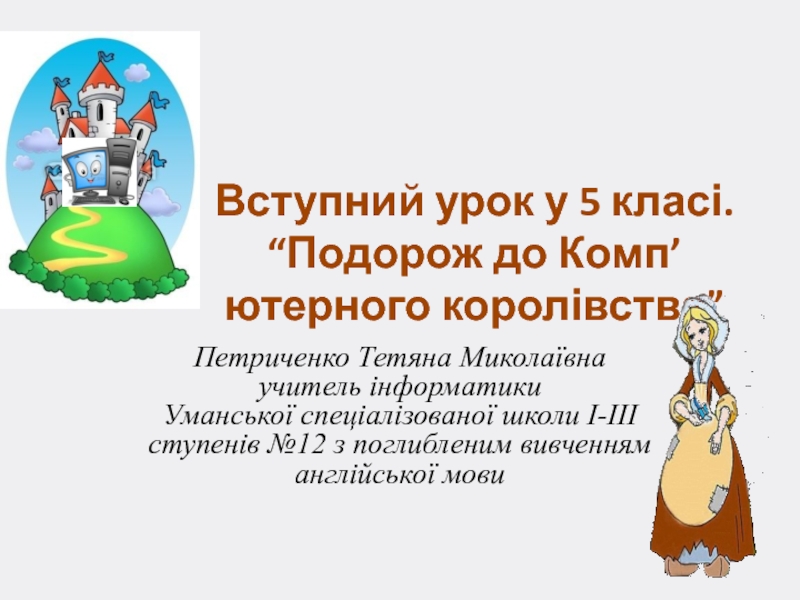- Главная
- Разное
- Дизайн
- Бизнес и предпринимательство
- Аналитика
- Образование
- Развлечения
- Красота и здоровье
- Финансы
- Государство
- Путешествия
- Спорт
- Недвижимость
- Армия
- Графика
- Культурология
- Еда и кулинария
- Лингвистика
- Английский язык
- Астрономия
- Алгебра
- Биология
- География
- Детские презентации
- Информатика
- История
- Литература
- Маркетинг
- Математика
- Медицина
- Менеджмент
- Музыка
- МХК
- Немецкий язык
- ОБЖ
- Обществознание
- Окружающий мир
- Педагогика
- Русский язык
- Технология
- Физика
- Философия
- Химия
- Шаблоны, картинки для презентаций
- Экология
- Экономика
- Юриспруденция
T-Tests in SAS презентация
Содержание
- 1. T-Tests in SAS
- 2. Introduction Suppose you want to answer the
- 3. T-tests can be used to answer
- 4. One-Sample T-test A one-sample t-test is used
- 5. Matched Pairs T-test A matched pairs t-test
- 6. Two-Sample T-test A two-sample t-test compares two
- 7. One-sample T-test in SAS We want to
- 8. Type the following code in SAS:
- 9. Tests for Normality The histogram shows most
- 10. SAS Code for a One-Sample T-test The
- 11. SAS Output for One-sample T-test
- 12. Interpreting Output From the SAS output, you
- 13. Conclusion If alpha = 0.05, then our
- 14. Matched Pairs T-test in SAS We want
- 15. Type the following code into SAS and run the program
- 16. Tests for Normality There are so few
- 17. SAS Code for Matched Pairs T-test PROC
- 18. SAS Output of a Matched Pairs T-test
- 19. Interpreting Output The difference of the mean
- 20. Conclusion If alpha = 0.05, then the
- 21. Two-Sample T-test in SAS We want to
- 22. Type the following code into SAS and run the program:
- 23. A few notes: Notice the variable “group”
- 24. Tests for Normality The tests for normality
- 25. Histograms for control and treatment groups
- 26. SAS Code for Two-Sample T-test Notice for
- 27. SAS Output for a Two-Sample T-test
- 28. Interpreting the Output: Pooled vs. Unpooled Variance
- 29. SAS conducts a formal F-test to
- 30. Conclusion The t* value for unpooled variances
Слайд 2Introduction
Suppose you want to answer the following questions:
Does a new headache
medicine provide the typical time to relief of 100 minutes, or is it different?
Does a weekend training session have an effect on performance on an exam?
Does a new headache medicine differ in time to relief from a standard headache treatment?
Does a weekend training session have an effect on performance on an exam?
Does a new headache medicine differ in time to relief from a standard headache treatment?
Слайд 3
T-tests can be used to answer all of these questions. There
are three main types of t-tests:
One-sample
Matched Pairs
Two-sample
One-sample
Matched Pairs
Two-sample
Слайд 4One-Sample T-test
A one-sample t-test is used to compare a sample to
an average or general population. You may know the average height of men in the U.S., and you could test whether a sample of professional basketball players differ significantly in height from the general U.S. population. A significant difference would indicate that basketball players belong to a different distribution of heights than the general U.S. population.
Слайд 5Matched Pairs T-test
A matched pairs t-test usually involves the same subjects
being measured on some factor at two points in time. For example, subjects could be tested on short-term memory, receive a brief tutorial on memory aids, then have their short-term memory re-tested. A significant difference in score (after-before) would indicate that the tutorial had an effect.
Слайд 6Two-Sample T-test
A two-sample t-test compares two groups on some factor. For
example, one group could receive an experimental treatment and the second group could receive a standard of care treatment or placebo.
Notice that in a two-sample t-test, two distinct groups are being compared, as opposed to the one-sample, where one group is compared to a general average, or a matched-pairs, where only one group is being measured twice.
Notice that in a two-sample t-test, two distinct groups are being compared, as opposed to the one-sample, where one group is compared to a general average, or a matched-pairs, where only one group is being measured twice.
Слайд 7One-sample T-test in SAS
We want to test whether a new headache
medicine provides a relief time equal to or different from the standard of 100 minutes.
Ho: µ=100
Ha: µ≠100
We have 10 observations of time to relief. Before we can test our hypothesis, however, we have to test the data for normality.
Ho: µ=100
Ha: µ≠100
We have 10 observations of time to relief. Before we can test our hypothesis, however, we have to test the data for normality.
Слайд 9Tests for Normality
The histogram shows most observations falling at the peak
of the normal curve.
The box-plot shows that the mean falls on the median (*--+--*), indicating no skewed data.
The formal tests of normality in the output are non-significant, indicating these data come from a normal distribution.
We can assume the data are normally distributed and proceed with the one-sample t-test.
The box-plot shows that the mean falls on the median (*--+--*), indicating no skewed data.
The formal tests of normality in the output are non-significant, indicating these data come from a normal distribution.
We can assume the data are normally distributed and proceed with the one-sample t-test.
Слайд 10SAS Code for a One-Sample T-test
The code is telling SAS to
run a t-test procedure on the variable relief, and the mean value of relief should be compared to a null value of 100.
After running this program, check your log for errors, then look at the output.
After running this program, check your log for errors, then look at the output.
PROC TTEST DATA = relieftime h0=100;
TITLE 'One-sample T-test example‘ ;
VAR relief;
RUN;
Слайд 12Interpreting Output
From the SAS output, you can see that the mean
relief time of the 10 subjects is 98.1 minutes. The calculated t* value = -1.28, and this test statistic has a p-value of 0.23 (this value is found under the label “Pr > |t|” which stands for the probability of getting a value greater than the absolute value of t*). This is a two-sided test. If this were a one-sided test, you would simply divide the p-value by 2.
Слайд 13Conclusion
If alpha = 0.05, then our p-value is greater than alpha.
Therefore, we fail to reject the null hypothesis. The new headache medicine does not provide a different time to relief from 100 minutes.
Слайд 14Matched Pairs T-test in SAS
We want to determine whether a weekend
study session improves students’ test scores. Six students are given a math test before the session, then they are re-tested after the weekend training. This is a matched pairs t-test, because the same subjects are being measured before and after some intervention.
Ho: µbefore = µafter
Ha: µbefore ≠ µafter
Again, before we can analyze the data, we have to determine whether we can assume the data come from a normal distribution.
Ho: µbefore = µafter
Ha: µbefore ≠ µafter
Again, before we can analyze the data, we have to determine whether we can assume the data come from a normal distribution.
Слайд 16Tests for Normality
There are so few data points that the histograms
are difficult to interpret.
The box-plots for before and after both show the mean very close to the median, suggesting the data are not skewed.
The tests of normality for before and after have p-values > alpha, indicating we do not reject the assumption of normality.
We can proceed with the matched pairs t-test.
The box-plots for before and after both show the mean very close to the median, suggesting the data are not skewed.
The tests of normality for before and after have p-values > alpha, indicating we do not reject the assumption of normality.
We can proceed with the matched pairs t-test.
Слайд 17SAS Code for Matched Pairs T-test
PROC TTEST DATA = study;
TITLE “Example
of Program for a Paired T-test” ;
PAIRED before * after;
RUN;
The code tells SAS to do a paired t-test on the data set study, and it will compare the difference of the means between before and after.
PAIRED before * after;
RUN;
The code tells SAS to do a paired t-test on the data set study, and it will compare the difference of the means between before and after.
Слайд 19Interpreting Output
The difference of the mean score (d-bar: before-after) is -7.33;
on average the scores before the weekend were lower than the scores after the training session. (If in your paired statement you had typed “after*before” the average difference would be 7.33.)
Is this difference statistically significant? To answer that question, look at the p-value. The t* for the test is -4.35, and the p-value is 0.0074.
Is this difference statistically significant? To answer that question, look at the p-value. The t* for the test is -4.35, and the p-value is 0.0074.
Слайд 20Conclusion
If alpha = 0.05, then the p-value < alpha, and we
reject the null hypothesis. Therefore, we can conclude that average scores are different before and after the weekend session, and the training does improve test scores.
Слайд 21Two-Sample T-test in SAS
We want to determine whether a new headache
medicine provides a different time to relief than a control medicine. Two groups of five subjects each are either given the treatment or control.
Ho: µ1 = µ2
Ha: µ1 ≠ µ2
Before we can conduct the two-sample t-test, however, we must determine whether the data come from a normal distribution.
Ho: µ1 = µ2
Ha: µ1 ≠ µ2
Before we can conduct the two-sample t-test, however, we must determine whether the data come from a normal distribution.
Слайд 23A few notes:
Notice the variable “group” is followed by a “$”
because it is a categorical variable
The code has specified that the univariate procedure be performed on the variable time, but that it is done by the class “group.” This way you will have separate summary statistics, plots and histograms for the treatment and control groups.
The code has specified that the univariate procedure be performed on the variable time, but that it is done by the class “group.” This way you will have separate summary statistics, plots and histograms for the treatment and control groups.
Слайд 24Tests for Normality
The tests for normality for both the treatment and
control groups are non-significant (p-value > alpha), indicating we can assume they come from a normal distribution.
Because each group only has 5 subjects, the histograms are difficult to interpret, but there is no indication of non-normality.
Proceed with the two-sample t-test
Because each group only has 5 subjects, the histograms are difficult to interpret, but there is no indication of non-normality.
Proceed with the two-sample t-test
Слайд 26SAS Code for Two-Sample T-test
Notice for a two-sample t-test you must
specify what distinguishes the two samples; in this case we compare the two samples defined by “group” (treatment and control), and we tell SAS to compare their mean “time” to relief.
Слайд 28Interpreting the Output: Pooled vs. Unpooled Variance
Before you can interpret your
test statistic and reach a conclusion, you must determine whether to use the pooled or unpooled variances test statistic. If we can assume the two samples have equal variances, then we use the pooled t*. If, on the other hand, we determine that the two samples have unequal variances, then we must use the unpooled t*.
Слайд 29
SAS conducts a formal F-test to determine whether the two groups
have equal variances:
Ho: σ12 = σ22 vs. Ha: σ12 ≠ σ22
If the p-value > 0.05, we fail to reject the null and can conclude the variances of the two groups are equal; thus we use the pooled variances t*.
If the p-value < 0.05, we reject the null and conclude the variances of the two groups are unequal; thus we use the unpooled variances t*.
You find the F-test under the heading “Equality of Variances” in your SAS output. In our case, the p-value (Pr > F) is 0.03, which is less than 0.05; we cannot assume σ12 = σ22 . We need to use the “t Value” from the “Unpooled” Method.
Ho: σ12 = σ22 vs. Ha: σ12 ≠ σ22
If the p-value > 0.05, we fail to reject the null and can conclude the variances of the two groups are equal; thus we use the pooled variances t*.
If the p-value < 0.05, we reject the null and conclude the variances of the two groups are unequal; thus we use the unpooled variances t*.
You find the F-test under the heading “Equality of Variances” in your SAS output. In our case, the p-value (Pr > F) is 0.03, which is less than 0.05; we cannot assume σ12 = σ22 . We need to use the “t Value” from the “Unpooled” Method.
Слайд 30Conclusion
The t* value for unpooled variances is -3.83, and the corresponding
p-value = 0.0141, which is less than alpha (0.05). Therefore, we reject the null and conclude that the treatment group differs significantly from the control group in time to relief from headache.
Notice from the SAS output that the treatment group took an average of about 20 minutes longer to feel relief than the control group (“Diff (1-2)”), implying the treatment is significantly worse than the control.
Notice from the SAS output that the treatment group took an average of about 20 minutes longer to feel relief than the control group (“Diff (1-2)”), implying the treatment is significantly worse than the control.
